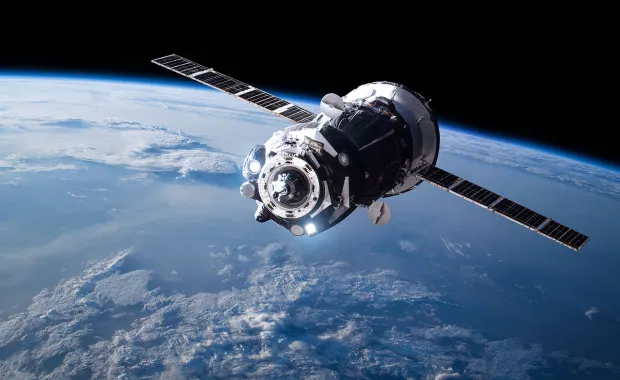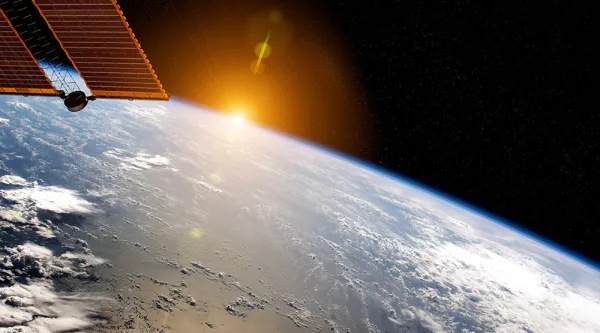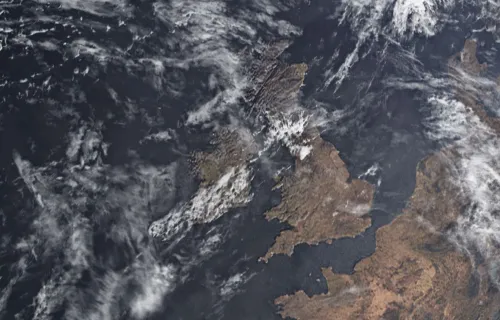Launching satellites into space requires both deep industry experience and technology expertise to successfully and securely navigate such a complex undertaking. Since the 1970s, we’ve helped our clients with the missions of more than 1,000 satellites. In delivering mission-critical space systems around the globe, we support major navigation, communication and Earth observation (EO) programs and share innovative uses of space technology and data with clients to solve key business challenges.
Following are some examples of how we partner with our space clients.
OneWeb
Greater connectivity has the power to improve the way business is done in the hardest to reach places, and change lives at scale. OneWeb’s innovative low Earth (LEO) orbit satellite system helps governments, businesses and communities better access, manage and scale connectivity on land, at sea and in the air. The company’s LEO network features 648 satellites in 18 carefully synchronized polar orbits. We developed and host OneWeb’s central resource management software which performs 8 billion calculations each day to determine the best network configuration for the satellites and ground stations.
“CGI has been instrumental in bringing OneWeb to service readiness, by delivering the central ground control systems that allow our network and satellite operations teams to oversee and manage the system resources and provide seamless and continuous coverage and availability to our customers. It has been a long journey, and CGI has been part of the OneWeb family since its early days. We are grateful for the continuous support that will extend to the operational phase, allowing OneWeb to maintain very high levels of customer service.”
— Michele Franci, OneWeb’s Chief of Delivery
Galileo
Galileo is the European Union’s global navigation satellite system. It currently comprises a constellation of 28 medium Earth orbit (MEO) satellites, growing to 30 later in 2022. Created through the European Space Agency (ESA) and designed for civilian use, Galileo provides highly accurate, guaranteed global positioning services that range from search and rescue to smartphone location features. We have been involved in the planning, implementation and deployment of Galileo since 2003. This includes the satellite system’s Public Regulated Service (PRS), which sends robust, resilient and encrypted signals exclusively for government-authorized users. At present, we are responsible for the PRS Key Management Facility (PKMF) infrastructure.
EGNOS
The EGNOS (European Geostationary Navigation Overlay Service) is a satellite-based augmentation system that improves the accuracy and reliability of GNSS positioning and timing information across Europe. The system has 3 GEO stationary satellites (2 operational, 1 test) that broadcast corrections and integrity information for GNSS satellites in the L1 frequency band.
The current version of EGNOS (V2) improves the accuracy of GPS in Europe and provides “integrity” information that warns the user when any signal is underperforming. CGI was involved in building the test bed used for verification of safety-critical functions, with faster than real-time simulations. Currently, we develop and maintain the Navigation Kernel Integrity Check Facility (NK ICF, aka Check Set) which meets one of the highest and most complex assurance levels. We also developed the S-NK ICF for System Platform for EGNOS Evolutions and Development (SPEED).
EGNOS V3 will include Galileo. For V3 phase C/D, CGI is responsible for the development, integration, verification and maintenance of the Command & Control Facility (CCF), Maintenance & Support Facility (MSF) and the Performance Assessment Facility (PAF). The CCF and MSF are based on CGI’s egmc² framework. We also contributed to the design of the initial phases, including the security and safety elements.
Meteosat
EUMETSAT is the European operational satellite agency for monitoring weather, climate and the environment from space. Four EUMETSAT Meteostat Second Generation (MSG) satellites over Africa, Europe and the Indian Ocean provide imagery for early detection of fast-developing severe weather, weather forecasting and climate monitoring. Throughout the 1970s, we were a major member of the various industrial consortia that developed the ground infrastructure for Meteostat. Today, we process image data from Meteostat satellites to extract weather information.
European Space Operations Centre (ESOC)
The European Space Operations Centre (ESOC) is home to the engineering teams that control spacecraft in orbit, manage their global tracking station network, and design and build the systems on the ground that support missions in space. Since 1967, more than 85 satellites belonging to ESA and its partners have been successfully flown from Darmstadt, Germany. For more than 35 years, CGI’s team of experts has worked alongside ESA and its contractors on spacecraft operations and ground control systems. We apply conventional information technologies, such as networking, cloud or knowledge management, to the unique needs of space users.
UN:IO
The European Commission’s UN:IO project aims to launch a constellation of more than 400 laser-linked communication satellites that will be operational by 2025. The constellation is designed to create a secure, sovereign, very fast European communications network for commercial and institutional use. We are contributing our space and cybersecurity expertise to UN:IO as part of a consortium of “new space” corporations, mid-sized companies and startups. We are building an innovative, automated concept of operations (CONOPS) for the constellation, developing specifications for comprehensive cybersecurity for its ground stations and systems, and designing security scenarios to enable concurrent use by private users and government institutions.
Learn more about our space experience and expertise.





